Rubella in babies and children
7-minute read
Key facts
- Rubella is a contagious disease that commonly causes a rash.
- Rubella is spread through close contact and by coughing and sneezing.
- There's no specific treatment for rubella and you can care for your child at home.
- Vaccination will stop most children from getting rubella.
What is rubella?
Rubella is a contagious disease. It’s also known as German measles or 3-day measles. However, rubella is not the same illness as measles.
Rubella is caused by the rubella virus. It’s uncommon among Australian children because of our National Immunisation Program.
Rubella is a mild disease that is not usually dangerous for children. But it can be very dangerous during pregnancy. This is because rubella can cause miscarriage or congenital disorders in unborn babies.
What are the symptoms of rubella?
In young children, the first sign of rubella is a pink or red rash. This usually begins on their face and spreads down the body.
The rash may appear as many small dots which together form a larger, reddened area. Sometimes the rash is itchy and can last for 3 to 4 days.
Other symptoms of rubella are:
- a slight fever
- headache
- sore throat and a runny nose
- generally feeling unwell
- swollen glands (especially at the back of your child's neck and behind their ears)
Symptoms generally begin to show about 14 days after your child has been infected with rubella.
CHECK YOUR SYMPTOMS — Use the Symptom Checker and find out if you need to seek medical help.
How do babies and children catch rubella?
Rubella spreads through:
- person-to-person contact
- exposure to droplets released when an infected person coughs or sneezes
A child with rubella can infect others from one week before their rash appears. They remain contagious up to one week after the rash appears.
When should I see my doctor?
If you think your child may have rubella, you should call your doctor straight away.
Do not go straight to the clinic — you don't want to infect people in the waiting room.
Call your doctor first. They will let you know the safest way to see them.
FIND A HEALTH SERVICE — The Service Finder can help you find doctors, pharmacies, hospitals and other health services.
How is rubella diagnosed?
Your doctor may be able to diagnose rubella from your child's symptoms and contact with someone who has the infection.
They may confirm the diagnosis with a blood test.
Rubella is a notifiable disease. This means that if your child has rubella, your doctor will notify your local public health unit. They may ask to talk with you to try and find out:
- where your child caught rubella
- who your child has spent time with (contact tracing)
This helps limit the spread of rubella and protects your community.
How is rubella treated?
There's no specific treatment for rubella and the disease is usually very mild.
Self-care at home
If you feel that your child is unwell:
- give them lots of fluids
- allow them to rest
- give them some paracetamol for pain or fever
- keep your child at home for at least 4 days after their rash appears
What complications can happen with rubella?
Rubella is often a mild illness. However, if you get rubella during your first 12 weeks of pregnancy, it can cause serious health problems for your baby, such as congenital rubella syndrome.
Rarely, rubella can cause encephalitis (inflammation of the brain).
How can rubella be prevented?
The best way to stop your child from catching rubella is through vaccination.
The rubella vaccine is given in 2 doses. This should happen at:
- 12 months of age — as part of the measles, mumps, rubella vaccine (MMR)
- 18 months of age — as part of the measles-mumps-rubella-varicella vaccine (MMRV)
Under the National Immunisation Program (NIP), these vaccinations are free.
However, if your child hasn’t had these vaccinations at the recommended age, talk to your nurse or doctor.
Vaccinating your child can also protect those around you. This includes other family members who are too young or too sick to get the vaccine.
The more people in your community who get the rubella vaccination, the more protected your community is from the virus.
How can I prevent the spread of rubella?
If your child has rubella, do not send them to childcare, kindergarten or school where they could infect others.
Learn more about school or childcare exclusion periods.
Make sure that you and your family are observing good hygiene practices, including washing hands both properly and frequently.
Teach your child the importance of sneezing and coughing into their elbow. This helps stop the spread of the rubella virus, and other illnesses.
It's especially important to keep your child away from people who are pregnant. The virus can be very dangerous to their unborn baby.
Resources and support
If you have any questions or concerns about rubella, speak to your doctor or child health nurse.
Learn more about how rubella during pregnancy can affect you and your baby.
Languages other than English
Health Translations Victoria has more information in English and other languages about:
- the MMR immunisation
- the MMRV vaccine

Speak to a maternal child health nurse
Call Pregnancy, Birth and Baby to speak to a maternal child health nurse on 1800 882 436 or video call. Available 7am to midnight (AET), 7 days a week.
Learn more here about the development and quality assurance of healthdirect content.
Last reviewed: June 2025










